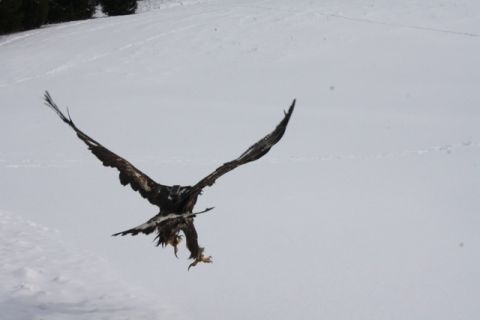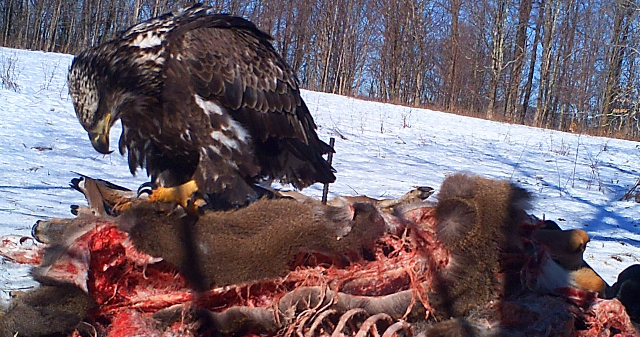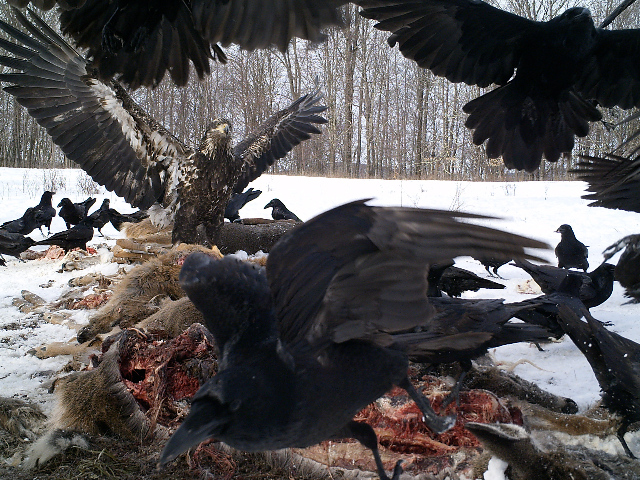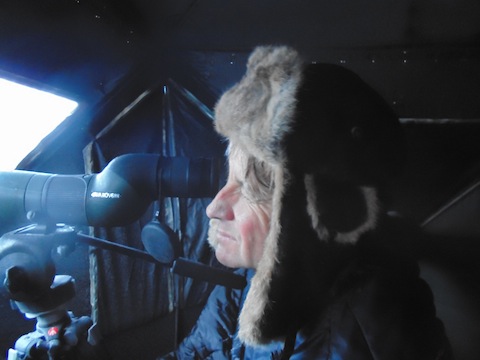
Above: Max being released into the wild on Saturday, February 8. Her GPS tracking device is visible on her back. Photo courtesy of Michael and Peg DiBenedetto.
Note from reporter Julia Reischel: I reported last week that a golden eagle named "Max" was captured and tagged with a solar-powered GPS device in the Catskills town of Andes on Saturday.
The eagle, now formally named "Maxine" because she has been positively identified as a female, was trapped as part of a program being run by the Delaware-Otsego Audubon Society in partnership with Todd Katzner, a golden eagle expert at West Virginia University.
Max was fitted with a patented solar-powered GPS tracking device attached to her back by a teflon ribbon. After several hours, she was released into the wild. Since Saturday, Audubon Society volunteer Tom Salo tells us, eagle watchers have spotted Maxine in the area "behaving normally."
The article I wrote generated lots of questions from our readers about golden eagles and the ethics of tracking and tagging them. I've spent a few days researching and talking to scientists to find some answers, which you can read below. To read the original story, click here.
Was this really the first time that a golden eagle was trapped and tagged with a tracking device in New York state?
No, I was wrong about this. According to Scott Van Arsdale, the New York Department of Environmental Conservation wildlife technician who trapped Max on Saturday, four golden eagles have been captured and tagged with tracking devices in New York state before this one.
'"DEC has banded nine golden eagles," Van Arsdale said. "Seven were wild caught. Four were fitted with PTTs -- all Argos units. The majority, if not all, were probably incidental to our bald eagle work. We used to trap bald eagles every winter."
But Max is the first golden eagle in New York to be tagged with this particular kind of tracking device, a GPS-GSM transmitter manufactured by Cellular Tracking Technologies that relies on the sun for power and the national cell phone network to regularly upload a stream of GPS data.
Todd Katzner, the scientist at West Virginia University who runs the nationwide golden eagle research program that Max will be contributing data to, also owns the company that manufactures these tracking devices.
Katzner said that 80 golden eagles across the United States have been fitted with this kind of tracking device.
"We have done about 50 in eastern North America and 30 in northern California," he said. "This is the first bird captured in New York that has gotten one of our transmitters."
The other four golden eagles that have been captured and tagged in New York were fitted with a tracking system using older technology called Argos PTT.
One of those golden eagles, named A00 after his leg band number, was trapped by Van Arsdale on March 11, 2003 on the Char-Marie Farm in Bloomville.
Van Arsdale fitted A00 with an Argos PTT tracker and a harness, which, he said, stopped working after 18 months.
Brian Haynes, who lives on the Bloomville farm where the eagle was captured, was there that day. He sent us photos of the eagle and a link to a blog post written at the time about the capture.
Left: Peter Nye (left) and Scott Van Arsdale (right) of the NY DEC hold a captured golden eagle in 2003. Photo courtesy Brian Haynes and the NY DEC.

Why are people studying the migration patterns of golden eagles?
Katzner runs a large wildlife monitoring project on the East Coast called Appalachian Eagles.
Under the project, about 50 volunteers and researchers run 200 "bait stations" stocked with roadkilled meat from Maine to Alabama. At the bait stations, photographs taken by motion-sensitive trail cameras capture images of eagles and many other animals coming and going.
Below: Eagles feeding at a bait pile in Delaware County. Photo by Michael DiBenedetto.

The golden eagle GPS tracking project run by Todd Katzner and the Delaware-Otsego Audubon Society is an outgrowth of the wildlife monitoring project. The GPS program has a more specific goal: to prevent golden eagles from being killed by wind turbines that may be constructed in the eastern United States.
"Wind energy kills a lot of birds and bats under certain circumstances," Katzner said. "Golden eagles are killed in large numbers in existing facilities in the western U.S. Many golden eagles are killed in Wyoming and California in particular."
Tom Salo, who directs the golden eagle research program at the Delaware-Otsego Audubon Society, wrote a letter to the Watershed Post in response to our article, which is published in full below. In it, he writes that golden eagles tend to fly along high mountain ridges, just where wind developers want to place turbines.
"We need to learn more about where soaring raptors concentrate," Salo wrote. "Right now, we have identified some areas. However, too little is known about the migration of our small eastern population of Golden Eagles to safely site many of these ridge top projects."
Katzner's team at West Virginia University recently published a paper in the journal Conservation Biology that used telemetry data to identify places in Pennsylvania where golden eagles fly lower than 150 meters off the ground. At that height, the eagles are at risk of running into wind turbines.
"We predicted for the entire state of Pennsylvania what would be high risk and what would be low risk," Katzner said. "We could never do that unless we had very detailed information on these birds. It's the first time to my knowledge that anybody has created a risk map at any size larger than a few miles for wind energy."
Are taxpayer dollars being spent on this project?
The Delaware-Otsego Audubon Society has raised private funds to cover the cost of the GPS transmitters that are attached to the golden eagles. Each transmitter costs the organization $2,500. Volunteers for DOAS collect road kill to use at bait piles and monitor the cameras for eagle sitings.
The only state money involved in the golden eagle project is the money that pays Scott Van Arsdale, a DEC staffer, for his time trapping and handling the birds. Otherwise, no state funds are spent on the project.
Are golden eagles really that rare?
Golden eagles are quite rare in New York, where they are listed as an endangered species.
According to the NY DEC, there are no nesting pairs of golden eagles in New York. Compare that to the bald eagle, which has made a great comeback in the state, with 173 breeding pairs that fledged 244 young in 2010.
Researchers estimate there are about 2,000 to 3,000 golden eagles in the eastern United States, according to Katzner and Salo.
According to the DEC and scientists and researchers on this project, golden eagles are easily confused with immature bald eagles, which they resemble closely.
"Many people believe they see goldens all the time. This isn’t true, though I would have believed the same thing had we not been studying these eagles for two years now," said Michael DiBenedetto, one of the volunteers who patiently collects frozen deer carcasses for remote-camera wildlife observation sites in Delaware County. "Golden eagles really are pretty rare here, and if you are seeing them down along the river, it’s probably not them, as they are not fish eagles as the Balds are."
Below: Photos of immature bald eagles, taken in 2014 and 2013 at Delaware County bait piles. Courtesy of Michael DiBenedetto.


To learn to tell golden eagles apart from immature bald eagles, check out the DOAS's Eagle ID guide.
Is Delaware County really a hotspot for golden eagles?
Golden eagle monitoring is still young in New York state, but so far, the data show that Delaware County -- and particularly Franklin Mountain, near Oneonta -- is a hotspot for the birds.
"The counts they get over Franklin Mountain are phenomenal," said Van Arsdale.
To see a daily count of all the bird sitings at Franklin Mountain, click here.
How did researchers trap Maxine?
Van Arsdale used a net to capture Max on Saturday. The net is positioned near bait -- usually deer carcasses -- and is launched by remote control.
"The net just settles down by gravity on the bird," he said. "It's relatively gentle and quite safe. I've caught numerous geese, turkeys and eagles with that net, and I've never lost a bird."
Below: DEC Biologist Scott Van Ardsdale waiting in a blind to launch a net over a golden eagle on a frigid morning. Photo by Tom Salo.

After she was trapped, what happened to Maxine?
Max was untangled from the net and then a falconer's hood was placed over her eyes to calm her down. She was measured and her blood was drawn.
She was in captivity for several hours while she was processed. I was there to witness volunteers handling Max. Most of the time she was held by human beings, and appeared very calm and relaxed.
The blood draw was performed by Christine Baldauf, a second-year veterinary student at SUNY Delhi, according to the Daily Star:
Baldauf, 37, said an experience in one of her SUNY Delhi classes prepared her for the task at hand.
“In Farm Animal Nursing, I had to draw blood from a chicken,” Baldauf said. “The technique was the same for the eagle, there were just a lot more feathers.”
How big and bulky is Max's GPS transmitter?
The telemetry unit Max was fitted with weighed 80 grams, Katzner said.
"That is less than 2.5% of the bird's body weight," he said. "It equivalent to what a person might be wearing in clothing. Probably less, especially on a winter day."
The harness that attaches the GPS device to Max is made out of a teflon ribbon and is designed to fit comfortably under her wings and out of her way.
How long do the harness and GPS device stay on the eagle?
According to Van Arsdale, the harnesses are designed to stay on the birds permanently.
Harnesses that are designed to fall off the bird after a period of time come with "extra risk that they'll get entangled," he said.
"They figure now it's safer for the bird to make a permanent attachment," he said. "There's always the chance that the bird will recaptured later and it can be removed."
This process of capturing eagles and putting permanent trackers on them seems invasive. Doesn't this stress the eagles?
Researchers agree that the process of capturing and tagging a golden eagle is unpleasant for the bird.
"It is a stress for them," said Van Arsdale. "They're used to being in the wild, and are not used to being handled."
A falconer's hood is placed over the eagle's head as soon as possible to help calm them down. When an eagle can't see, it relaxes. The environment is also kept whisper-quiet to keep the birds calm.
"When you put the hood on them, they can't see anything and they almost immediately turn to jello," Van Arsdale said.
After eagles are released, scientists and bird watchers say that they are not bothered by having GPS units strapped to their backs.
Brian Hayes, who saw the golden eagle tagged with a tracking device on his farm in Bloomville after it was tagged, said that it seemed like the tracking device "didn't bother him at all."
Sometimes, however, bird bands can cause problems. In 2011, a red-tailed hawk named Violet died of a heart attack in New York City. Violet died after having surgery for an injured foot, and the injury may have been exacerbated by the bird band on her foot.
"We make every effort to ensure the bird's safety," said Van Arsdale. "To get the scientific data, you do have to put the individuals through the process. It's the only way."
Can't we get enough data about the eagles in non-invasive ways?
The scientists and researchers involved in the golden eagle project in New York say that tagging the eagles with GPS transmitters is the only way to get certain kinds of data that will help the bird population in the long run.
"We're getting data that we could've never got in the past," said Van Arsdale. "You can't be everywhere. They're getting elevation data, how fast the bird is flying, how high it is, where it's frequenting ... You'd need 500 people out in the field all day every day collecting data to get that."
"We do not find pleasure in stressing wildlife," writes Tom Salo in his letter. "However, the cost benefit equation is clear. This research is already saving Golden Eagles. Max had an uncomfortable couple of hours in captivity but now she is helping protect her species by sharing with us the details of her life.
"I don’t think anyone involved in this trapping didn’t feel for the bird," said DiBenedetto. "But hopefully this research will allow us, our children and generations to continue to see these magnificent birds."
-----------------------------------
Below: A letter to the Watershed Post from Tom Salo, the research coordinator for the Delaware-Otsego Audubon Society's golden eagle project.
Dear editor:
In reading the comments on your story it is clear that many people do not understand why we trapped Max. There is also a need to explain the difference between a juvenile Bald Eagle (an increasingly common bird which will often be seen sitting beside a lake or river) and a Golden Eagle (a rare bird that is seldom seen by the public). The two birds can be easily confused. Because I want to keep this letter a reasonable length, I recommend readers learn the difference by using any good raptor field guide or by reading this article – http://doas.us/wp-content/uploads/2013/04/Nov2007EagleID.pdf.
Since 1989, the Delaware-Otsego Audubon Society has been counting raptors at the Franklin Mountain Hawk Watch in northern Delaware County. Averaging 160 migrating Golden Eagles each fall, it has become “the” place to see goldens in New York. On a good day the birds are flying 200 feet off the ground using the updraft from the ridge to glide effortlessly. This migratory behavior, where birds concentrate along ridges, is typical of Golden Eagles. Unfortunately, it puts the birds in the very same space that developers target for siting wind power projects. As many as 60,000 wind turbines will be required too reach national energy goals. Many will be built along the ridges of New York and Pennsylvania. Some of those ridges will attract raptors like Franklin Mountain. As a species, Golden Eagle is especially vulnerable to wind turbines. It has been called the species which “appears to be at the highest risk” from wind development.
At poorly sited wind projects, thousands of raptors have been killed, including hundreds of Golden Eagles in the western U.S. Our organization supports wind as an alternative to fossil fuel use. However, we need to learn more about where soaring raptors concentrate. Right now, we have identified some areas. However, too little is known about the migration of our small eastern population of Golden Eagles to safely site many of these ridge top projects.
Since 2007 we have been involved with Dr. Todd Katzner's research group based at the University of West Virginia. Their research includes the GPS tracking of Golden Eagles to help determine where eagle-safe wind power projects can be built. Using their telemetry data, we identified 2 focus areas where we counted migrating raptors in the spring of 2009 and 2010.
The 2009 counts in western Delaware County found a significant number of eagles passing through a narrow area. 100 eagles of both species were recorded in 9 days.
This past spring we learned of a local wind project that was thought by the developer to be in a safe area but in fact had a significant presence of Golden and Bald Eagles. We knew about eagles at that site because of Dr. Katzner's telemetry data, and the results from our 2009 spring counts in Delaware County. Our limited data completely changed the eagle risk assessment for that project. These data are only available because of the trapping of eagles such as Max.
Since the winter of 2010, we have operated baited camera traps at a dozen locations in Delaware and Otsego Counties to help determine the winter distribution of Golden Eagles. Unexpected numbers – albeit small numbers - of this rare species were found to be in our area.
Until this winter, all GPS tracked goldens being used in Dr. Katzner's models were captured south of central PA. Our winter resident birds behave differently from the birds that winter down south. Max and others like her will improve these models being developed by Golden Eagle researchers by adding data from wintering New York birds.
Our organization is committed to protecting this species. We have spent tens of thousands of dollars on research. Our volunteers contribute over 1000 hours of their time each year counting migrating raptors and running camera traps. We feel Golden Eagles need not suffer from our ignorance.
We do not find pleasure in stressing wildlife. However, the cost benefit equation is clear. This research is already saving Golden Eagles. Max had an uncomfortable couple of hours in captivity but now she is helping protect her species by sharing with us the details of her life.
Two days after being trapped she was seen behaving like a normal eagle.
Note: Max was captured using a 20' X 20' net launched over bait by remote control. The device on her back is extremely light and will not hinder her activities. The teflon harness works its way beneath her feathers so it will not become entangled.
Tom Salo
DOAS Research Coordinator















